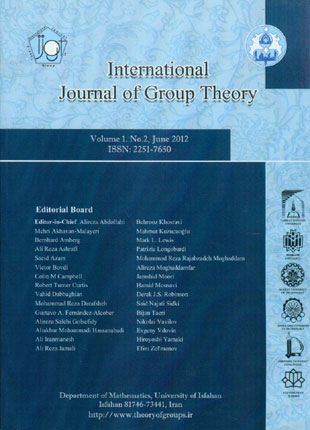فهرست مطالب

International Journal of Group Theory
Volume:1 Issue: 2, Jun 2012
- تاریخ انتشار: 1391/01/19
- تعداد عناوین: 6
-
-
صفحه 1نوع جدیدی از نمایش برای یک گروه چند دوری را برای زمانی که سازگار باشد، توصیف می کنیم. این نمایش با تظریف یک سری از زیرگروه های نرمال با بخش های آبلی به دست آمده است. این نمایش ها به طور موثری در سیستم های کامپیوتری برای جبر مانند PAG یا AMGAM قابل توصیف هستند. این گونه نمایش ها را مطالعه می کنیم و به ویژه محک هایی برای سازگاری آنها به دست می آوریم. اجرای این سازگاری نشان می دهد، شرایطی وجود دارد که درآن روش های جدید سریع تر از روش های موجود برای گروه های چند دوری است.
-
صفحه 25نتایج بسیاری در مورد ساختار گروه های متناهی که دارای محدودیت هایی بر عناصر حقیقی و بر رده های مزدوجی خود دارند، به اثبات رسیده است. تعداد کمی از این نتایج را به رده هایی از گروه های نامتناهی تعمیم می دهیم. گروه هایی را که در آنها عناصر حقیقی مرکزی هستند، گروه هایی که در آنها عناصرحقیقی 2-عنصر هستند، گروه هایی که در آنها همه رده های مزدوجی غیر بدیهی تعداد عناصر متناهی یکسان دارند و CF- گروه هایی با دو نوع رده مزدوجی غیر بدیهی از لحاظ تعداد عناصر را مطالعه می کنیم
-
صفحه 39
-
صفحه 51فرض کنیم G یک گروه p-حلپذیر متناهی، وP یک p- زیرگروه سیلو از G باشد. در این مقاله ثابت شده 4 برای 2 = p) در k-ام جمله از سری مرکزی بالا ازP قرار داشته یاشند، آنگاه p-طول G حداکثر 1+m2 /G حداکثر pm است. هم چنین ثابت شده است که اگرP یک p-گروه قدرتمند باشد، آنگاه p-طول G برابر با 1 است.
-
صفحه 59y, x. ثابت می کنیم برای یک p-گروه p- مرکزی 2p- آبلی متناهی G، به استثنای حالاتی خاص، مرتبه G مرتبه (G)tuA را می شمارد.
-
Page 1We describe a new type of presentation that، when consistent، describes a polycyclic group. This presentation is obtained by re ning a series of normal subgroups with abelian sections. These presentations can be described e ectively in computeralgebra- systems like Gap or Magma. We study these presentations and، in particular، we obtain consistency criteria for them. The consistency implementation demonstrates that there are situations where the new method is faster than the existing methods for polycyclic groups.
-
Page 19Let n be an integer. A group G is said to be n-abelian if the map phi_n that sends g to g^n is an endomorphism of G. Then (xy) ^n=x^ny^n for all x،y in G، from which it follows [x^n،y] = [x،y] ^n= [x،y^n]. It is also easy to see that a group G is n-abelian if and only if it is (1-n) -abelian. If nneq 0،1 and G is an n-abelian group، then the quotient group G/Z (G) has finite exponent dividing n (n-1). This implies that every torsion-free n-abelian group is abelian. We denote by B_n and C_n the classes of all groups G for which phi_n is a monomorphism and an epimorphism of G، respectively. Then B_0=C_0 contains only the trivial group، B_1=C_1 is the class of all groups، and B_-1=C_-1 is the class of all abelian groups. Furthermore، with |n|>1، G is in B_n if and only if G is an n-abelian group having no elements of order dividing |n|. Similarly، G is in C_n if and only if G is n-abelian and for every g in G there exists an element x in G such that g=x^n. We also set A_n=B_ncap C_n. In this paper we give a characterization for groups in B_n and for groups in C_n. We also obtain an arithmetic description of the set of all integers n such that a group G is in A_n.
-
Page 25Many results were proved on the structure of finite groups with some restrictions on their real elements and on their conjugacy classes. We generalize a few of these to some classes of infinite groups. We study groups in which real elements are central، groups in which real elements are 2-elements، groups in which all non-trivial classes have the same finite size and FC-groups with two non-trivial conjugacy class sizes.
-
Page 39The aim of this paper is to study the $ (alpha، gamma) $-prolongation of central extensions. We obtain the obstruction theory for $ (alpha، gamma) $-prolongations and classify $ (alpha، gamma) $-prolongations thanks to low-dimensional cohomology groups of groups.
-
Page 51Let $G$ be a finite $p$-soluble group، and $P$ a Sylow $p$-sub-group of $G$. It is proved that if all elements of $P$ of order $p$ (or of order ${}leq 4$ for $p=2$) are contained in the $k$-th term of the upper central series of $P$، then the $p$-length of $G$ is at most $2m+1$، where $m$ is the greatest integer such that $p^m-p^ {m-1} leq k$، and the exponent of the image of $P$ in $G/O_ {p''،p} (G) $ is at most $p^m$. It is also proved that if $P$ is a powerful $p$-group، then the $p$-length of $G$ is equal to 1.
-
Page 59A p-group is p-central if the central quotient has exponent p، and G is (p^2) -abelian if (xy) ^ {p^{2}}= (x^ {p^2}) (y^ {p^2}) for all x،y in G. We prove that for G a finite (p^2) -abelian p-central p-group، excluding certain cases، the order of G divides the order of Aut (G).

